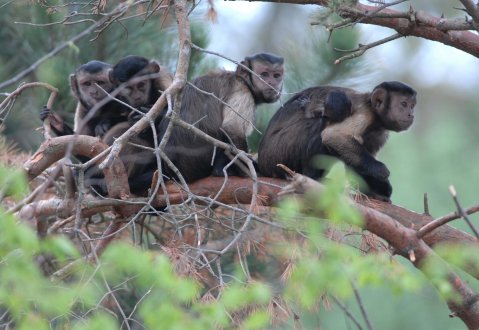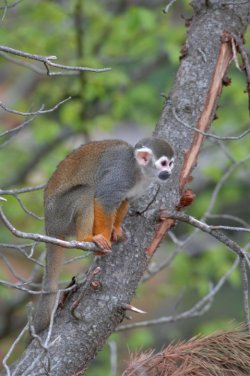What makes us human?

Renowned primatologist Dr Jane Goodall will arrive in Scotland today (Tuesday 20 May 2008) to officially open a unique centre dedicated to understanding the origins of human behaviour.
Dr Goodall, whose landmark research is credited with redefining the relationship between humans and animals, will open the pioneering Living Links to Human Evolution Centre, an innovative partnership between the University of St Andrews and the Royal Zoological Society of Scotland.
The £1.6m state-of-the-art facility at Edinburgh Zoo will provide St Andrews’ researchers, already internationally renowned for their studies of wild monkeys and apes, with the opportunity to observe more detailed aspects of the primates’ behaviour closer to home.
Professor Andrew Whiten of the University of St Andrews is Director of the new Centre. He said, “We humans are primates, and by great good fortune, numerous other species of primates have survived millions of years of evolution and by natural selection to share the planet with us today. They are the closest living links to Homo sapiens and they are precious living links to our past. Ingenious studies of these primates have recently provided many insights into the origins of the human mind.
“Some big questions will lie behind our research at the new Living Links centre, such as `what makes us human?’ We want to find out all the ways in which these primates share some of our mental abilities, and just where the differences begin.”
Dr Goodall’s pioneering research into chimpanzee behaviour over the last forty years began at Gombe National Park, Tanzania in 1960, where she discovered the first tool use in a non-human primate species. She defied scientific convention by giving the chimps she observed names instead of numbers, and insisted that her observations proved that animals have distinct personalities, minds and emotions. Her work became the foundation of future primatological research, and in 1977 she founded the Jane Goodall Institute, a global leader in the effort to protect chimpanzees and their habitats.
 The purpose-built new centre is a unique combination of field station and research centre which has recreated mixed-species communities of capuchins and squirrel monkeys that are natural in the wild. This will allow the researchers to monitor interaction between the two South American species and ultimately will help researchers understand the cultural connections we share with our primate relatives.
The purpose-built new centre is a unique combination of field station and research centre which has recreated mixed-species communities of capuchins and squirrel monkeys that are natural in the wild. This will allow the researchers to monitor interaction between the two South American species and ultimately will help researchers understand the cultural connections we share with our primate relatives.
St Andrews’ researchers have already made numerous discoveries relating to non-human primate behaviour and their links to human evolution. Professor Whiten explained, “We already have some evidence that different groups of monkeys develop different local traditions, which suggests a simple form of ‘culture’. Living Links has been specially designed to have two separate but similar enclosures, so we are going to be able to make new discoveries here about the extent to which new forms of behaviour we start off in one group does spread to become a local tradition, not found in the other group. For example, will they learn new things from each other?”
Studies will include observations of tool use, communication, social relationships and intelligence in monkeys, which researchers hope will illuminate the origins of human behaviour. Deputy Director of the new centre, Dr Klaus Zuberbühler, also of the University of St Andrews, explained, “Another area of investigation relates to language – we want to know how well the monkeys use their different vocalisations to communicate about different things important to them in their world, like predators such as hawks and foxes.
“Another project will look at just how much they understand about ‘everyday physics’ such as how objects can be expected to behave under the influence of gravity,” he said.
A variety of studies will be undertaken by members of the Scottish Primate Research Group, which spans the Universities of St Andrews, Stirling, Edinburgh and Abertay.
Through the observation of the two matched, mixed-species groups, Living Links will also provide extraordinary and unparalleled opportunities for public engagement with science, only matched by a handful of zoos throughout the world.
David Windmill, Chief Executive of the Royal Zoological Society of Scotland which owns Edinburgh Zoo, said, “The collaboration between the Royal Zoological Society of Scotland and University of St Andrews to produce Living Links combines these organisations’ strengths and resources to produce something of real value to the worlds of academic research and wildlife conservation which will be readily accessible to our visiting public.”
Professor Whiten said, “The staff of Edinburgh Zoo will devote their considerable expertise to the care of the primates. Another rather different line of research led by Professor Hannah Buchanan-Smith of Stirling University, is very much focussed on the primates in their own right, where we are carefully examining welfare questions, such as the benefits and costs of sharing space with other species.
“We think we are pretty successful at making voluntary participation in our research enjoyable and enriching for the animals themselves.”
Dr Goodall will open the new centre jointly with Professor Sir Michael Atiyah, President of the Royal Society of Edinburgh. Following the opening event, Dr Goodall will deliver a public talk at Edinburgh University. For further information on both events visit www.living-links.org
ENDS
NOTE TO EDITORS:
Professor Andrew Whiten is available for interview in advance on 01334 462073 / 0781 736 8637.
YOU ARE INVITED TO ATTEND THE OFFICIAL OPENING OF LIVING LINKS AT EDINBURGH ZOO AT 2.45PM ON TUESDAY 20 MAY 2008. DR JANE GOODALL AND THE RESEARCHERS INVOLVED WILL BE AVAILABLE FOR INTERVIEW / PHOTOGRAPHS.
Please meet Maxine Finlay, Communications Officer for Edinburgh Zoo, at the Mansion House NO LATER THAN 2.30PM. On arrival, please park in the main visitors car park and enter the Zoo through the Members Gate at the north-west corner of the car park. Contact Maxine on 07730 650966.
Living Links has been created through a £1.6M grant from the Strategic Research Development Scheme of the Universities’ Scottish Funding Council, which recognises peaks of scientific excellence in Scotland. Living Links supports studies by an internationally recognised consortium of scientists at the Universities of St Andrews, Stirling, Edinburgh and Abertay, the Scottish Primate Research Group (SPRG).
The SPRG has built a reputation as the most prominent primate research group in the UK and one of the leading consortia of this kind in the world. The creation of Living Links recognises the special status of primatology in Scotland.
NOTE TO PICTURE EDITORS:
IMAGES ARE AVAILABLE FROM THE PRESS OFFICE – CONTACTS BELOW.
Issued by the Press Office, University of St Andrews
Contact: Fiona Armstrong, Press Officer on 01334 462530 / 467227, 07730 415 015 or email [email protected]
Ref: Living Links 190508
View the latest University press releases at www.st-andrews.ac.uk
Category Research